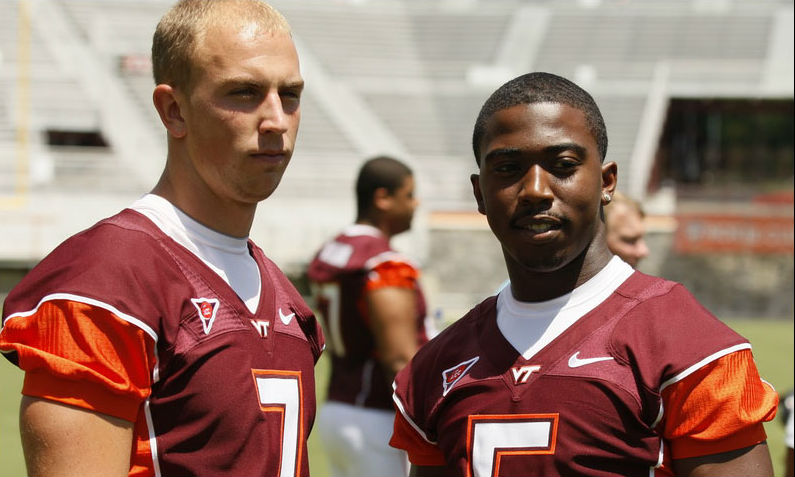Between Tua Tagovailoa and Jalen Hurts, Alabama has the most intriguing QB battle in the nation heading into this fall. A lot of the takes surrounding this competition indicate that Nick Saban can have one under center or the other. Both could become transfer candidates if one or the other is given the reigns to the Alabama offense.
This does not have to be the case. Two-QB systems have worked in college football in a variety of ways. In fact, such systems have worked for good, potentially elite teams.
Tyrod Taylor & Sean Glennon, Virginia Tech
The 2007 edition of Virginia Tech featured the two quarterbacks mentioned above. In addition to beating Texas, the Kansas Jayhawks beat the Hokies in the Orange Bowl that season. Virginia Tech opened the season at home against East Carolina and College Gameday was present in Blacksburg in honor of Tech’s first home game since the shooting that occurred in April of that year. Virginia Tech finished the season 11-3 with their only three losses being to two #2 teams (LSU, Boston College) and #8 Kansas in the Orange Bowl. The Hokies had a pretty good year.
Glennon and Taylor brought two different elements to the Hokie offense. Glennon was considered the pocket passer and Taylor brought a very good arm to accompany his mobility.
Taylor threw for almost a thousand yards and chipped in 429 rushing yards, which made him Tech’s second-leading rusher. Head coach Frank Beamer had two quarterbacks who could throw and push the ball downfield, and one who could change plays with his feet. There are worse problems to have. In essence, Virginia Tech could bring multiple looks and be a nightmare for opposing defenses to prepare for. They averaged 28.7 points per game. Given their defensive numbers, that was more than enough. 28 points would have won them every game except for the 48-7 drubbing they received from LSU that season.
Everett Golson & Tommy Rees: The Closer
Notre Dame returned to glory in 2012 (kind of). They went 12-0, beating three ranked teams along the way in Michigan State, Oklahoma and Stanford. The magic would stop against Alabama in the BCS title game. That was not so fun for Notre Dame.
Everett Golson came in and lead the Irish to big wins time and time again. However, they weren’t always clean. Incumbent QB Tommy Rees handed the reigns over to Golson as the full-time starter. Starting with the second game of the season against Purdue, Golson would give way to Rees late in games. Rees essentially became the “closing pitcher” when Golson was unable go the distance. After another shaky start against Michigan, Rees came in as relief to Golson to rally the troops to another win. This occurrence would become a theme for the season as Rees saw significant action in all twelve games. He would throw for more than 100 yards twice, against Michigan and BYU.
Golson was the go-to guy when he was on his game. With that not being the case all that consistently, Rees became an integral part of Notre Dame’s undefeated regular season in 2012. That, and their monstrous defense.
The Verdict
I completely understand if one of the Alabama QB’s wants to transfer should they not get the job. These are two phenomenal players with plenty of eligibility ahead of them. Alabama fans should be happy with whichever one starts. If one leaves? Cool. Alabama is gonna be Alabama. There are worse problems to have than this.
But let’s say that they both stick around. With the talent that Alabama has at every position, this could work out for both QB’s. They both have things that they bring to the table and contribute when they’re needed. There’s no reason that there should be an ultimatum for either quarterback based off of who wins this competition for the starting role.






